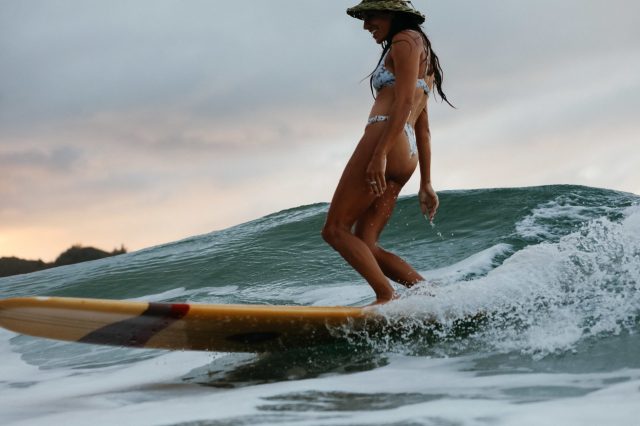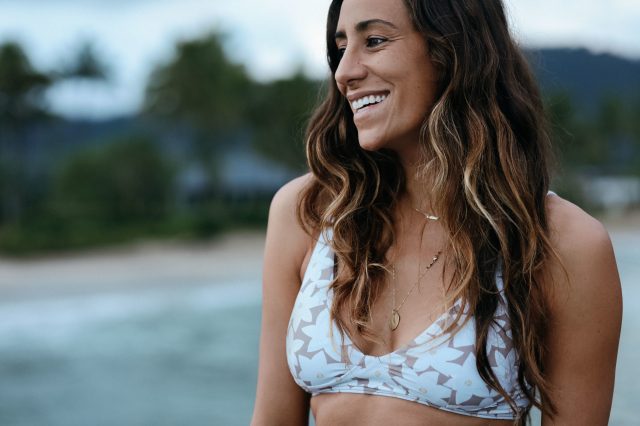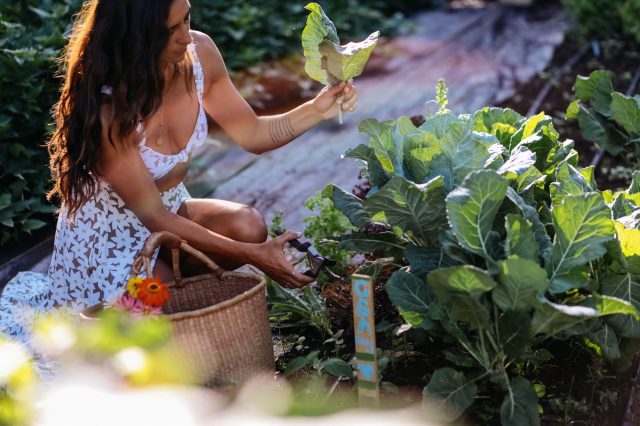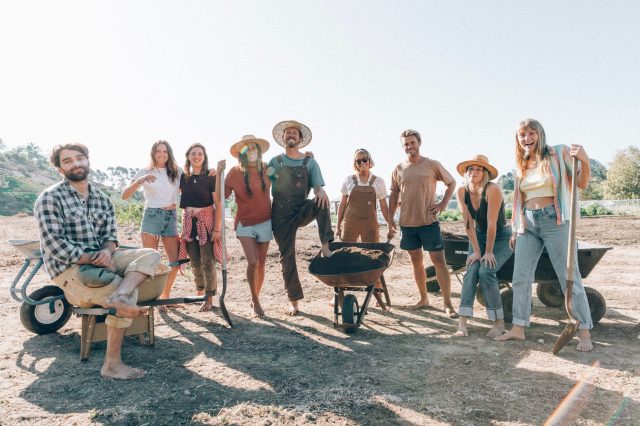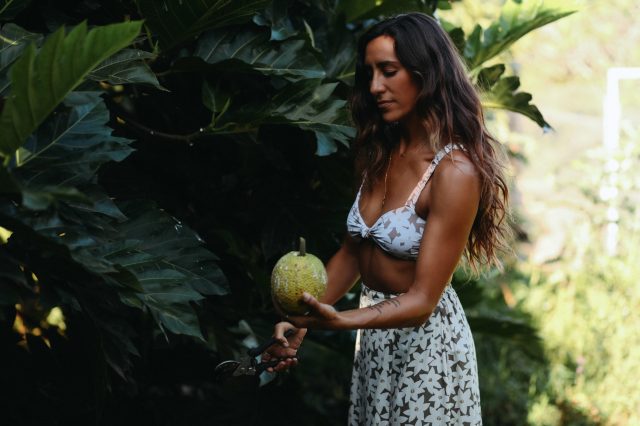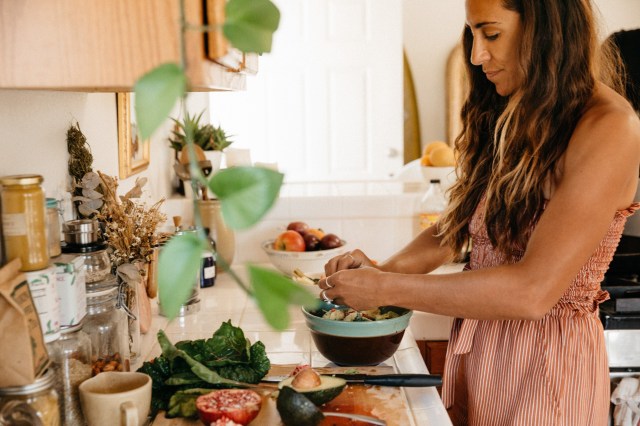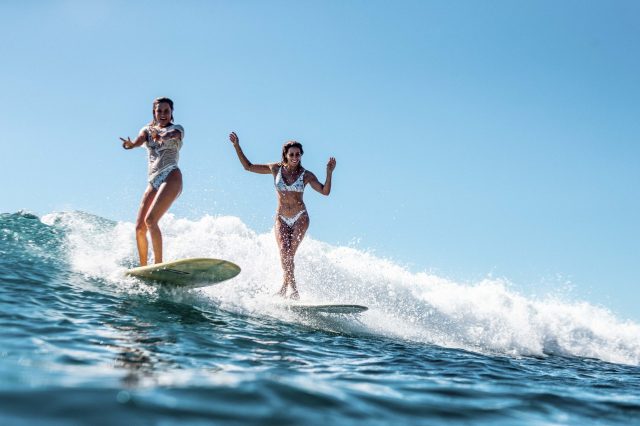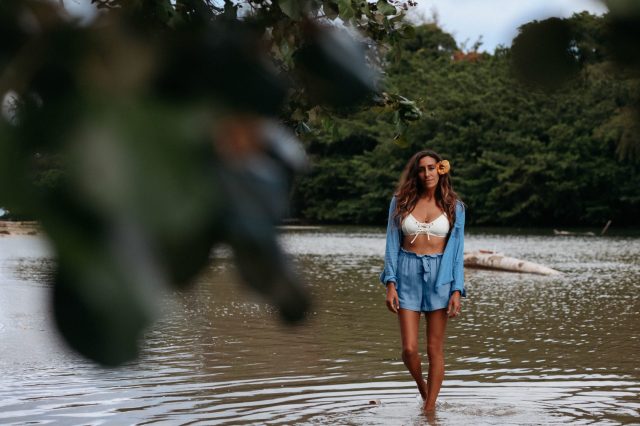This piece was produced in partnership with Billabong.
In 2013, Lex Weinstein sold all her belongings, quit her job as a visual merchandiser in St. Augustine, Florida, and started traveling and surfing around the world.
She worked odd jobs and freelance gigs as a writer, producer and stylist to support her exploration, roaming exotic destinations like Indonesia, Sri Lanka, Samoa and Morocco.
Weinstein says surfing has filled her with a sense of obligation to advocate for the environment.
“For 5 years, I was living very minimally, collecting experiences, not things, but I would notice on my travels the direct impact of human’s overconsumption on the planet,” says Weinstein, now based in Encinitas, California. “I saw firsthand that the communities that have the least to do with climate change are the first to suffer the consequences.”
Though her travel was fueled by a desire to surf perfect waves in far-flung places, her focus shifted as she encountered environmental degradation nearly everywhere she went. “Waste management issues triggered by the Western world were affecting less developed societies, particularly with our addiction to single-use plastics,” she says. “Once you see those things in the most beautiful pockets of the world, you can’t unsee them.”
Weinstein began a personal evaluation and self-education on how she was contributing to environmental problems and how she could mitigate her impact. Her journey coincided with the shift of social media from just a place to post photos to a forum for communicating ideas, and she amassed a sizable following of people who were both inspired by the beautiful locales she posted about and shared her concern for their future.
Weinstein’s travels drove her to share with others what she witnessed and inspire action.
“I felt this duty to use my platform in a grassroots way and help in whatever ways I could,” says Weinstein. Today, she sees social media as a powerful tool to ignite action against climate change. She has become an environmental activist, sharing the practices she adopts in her own life to inspire others—particularly her fellow surfers—to live more harmoniously with the earth.
We sat down with Lex to learn more about her environmental mission, how surfers can help fight climate change, and her new collaboration with Billabong: the
the Hello! Tomorrow Eco Friendly Collection.
After traveling the world and living abroad, Weinstein made lifestyle shifts to live more harmoniously with a vulnerable planet.
As you were traveling, surfing and becoming interested in environmental issues, how did you educate yourself on them?
By getting my Permaculture Design certification, I got a chance to understand that there was a way to live in harmony with the environment, and to see how, for indigenous cultures throughout history, this was always how they lived, and it was only a matter of looking to our past to inspire our future.
I got a chance to live on an organic farm on Kauai for 6 months, where I slept in a tent on the land, woke up and surfed, worked in the soil, ate from the garden, and returned back to the sea. I realized that the sea and the soil are the best medicine for what ails us and it became a passion I wanted to share.
I also took a Corporate Sustainability course through NYU, which confirmed for me that purpose and profit are not actually at odds. There’s 20 years worth of data that shows that social and environmental responsibility are critical elements of the future of business.
As part of her environmental self-education, Weinstein immersed herself in permaculture design and organic farming.
What are the most impactful ways surfers can make a difference in protecting the environment and stemming climate change?
Number one is vote. Voting for politicians with aggressive environmental proposals, showing up and mobilizing in large numbers to vote is huge. Number two is to show up as a community to inspire healthy change. Go to city council meetings and just show up as a community to be aware and be part of the solution. It can be extremely simple. For example, I started a gardening club here in Encinitas called Sea + Soil where we disconnect from technology and reconnect to the land by spending one morning a month surfing together and then volunteering at a local farm. The discussions we have in the lineup and the garden inspire change in just a few hours.
Weinstein founded the Sea + Soil surf and gardening club to reconnect surfers to the land.
Number three is assessing daily habits and holding ourselves accountable. I live by a standard of 80/20 in terms of everyday choices, holding “progress not perfection” as a mantra. This means making the best choices I can whenever possible, but not feeling paralyzed by the thought of failure. Try to cut out single-use plastics, take on a vegetarian diet, even just once or twice a week. Support local farmers by shopping at farmer’s markets, growing your own food is even better. Reduce flying. Educate yourself, and engage your family and friends in conversation around these issues. Meet them in whatever stage of the journey they’re at, and lead by example rather than preaching.
Eating locally and adopting partial or fully vegetarian diet are ways to lessen one’s climate impact.
Have beach cleanups and successful campaigns about ocean plastics distracted surfers from facing some of the more inconvenient changes we need to make to protect the environment?
I look at this as an “and” rather than an “or” issue. Beach cleanups are a powerful, multi-layered educational tool to convene community and discuss the root of the problem. However, they are definitely not enough.
There’s a certain point at which one graduates from the beach cleanup and needs to look deeply at the issues we’re facing, the daunting statistics and facts—like that we have 11 years before there are irreversible effects on the planet.
Once you know, you have to take the next step, you can’t look away. We need everyone engaged at every level. And the next step is to take action, however feels authentic and effective to you.
What are some of the things that you have done to lessen your personal impact?
I live by the suggestions I shared earlier. On the flying part, I feel that travel is really important, because it helps me to understand our human connection and the issues we are all facing on a more personal level. But I moved back to the U.S. to reduce the distance I needed to fly for work and to see my family.
I also realized that every day that I spend money, I’m voting with my dollar. The restaurants I go to, the food I buy, the products I choose, they’re all making a statement about my values.
When I began to understand my personal power, I decided to use my platform to help others do the same. That’s when I came up with my Conscious Collab Checklist, a list of ethical and environmental criteria for my clients and the companies I support. Any brand I work with has to check off at least three of the fifteen ethical and sustainable practices listed, and I encourage others to do the same.
Weinstein sees every purchase she makes as an opportunity to vote her values.
What’s an example of a company that has heeded the Conscious Collab Checklist?
Billabong recently invited me to be the face of their Hello! Tomorrow Collection, the brand’s first-ever responsibly made capsule of apparel, wetsuits, swim and accessories. It was such an honor when the head of global sustainability told me that when I first released my checklist, it inspired them to keep steering Billabong in a direction where it could begin to meet its guidelines, and once they felt they were making tangible progress, they reached out about working together.
Can you tell us more about your partnership with Billabong?
The first time I met with the team, I told them that I didn’t just want to help market sustainable clothing. I wanted Hello! Tomorrow to inspire a surfers’ movement. Billabong’s platform is so huge, we should use it to activate surfers as environmental warriors.
I started by taking over the Billabong houses on the North Shore during the triple crown, implementing compost systems, water refill stations and locally-sourced produce. I also hosted a 35-woman workshop at Billabong headquarters to help them understand their power and position in a grassroots way, that every decision they make whether it’s in accounting or production is critical and leads to a larger change on the corporate level.
Overall, I’m impressed with the eagerness of the team to make shifts at every level. They’ve made strides, and are working towards switching to recycled poly bags and smaller folding techniques for shipments. Billabong is also working with HIGG’s self-evaluation tools to measure the social and environmental impacts of their operations and make meaningful improvements where they can.
What makes the Hello! Tomorrow Collection environmentally friendly?
Billabong’s starting point is using upcycled and recycled fabrics and fibers to reduce what ends up in a landfill or in our ocean, as well as using sustainable fabrics certified by third parties. With their apparel, that means using FSC (Forest Stewardship Council)-certified rayon, a fiber sourced from trees, as well as upcycled fabric scraps from the factory floor. The swimwear is made with recycled yarns, and the wetsuit neoprene uses water-based adhesives, jersey made from 87 percent recycled polyester from plastic bottles, and 13 percent recycled spandex, plus foam that’s 30 percent recycled rubber from car tires and dope dyed yarns which reduce water usage by 90 percent from traditional methods.
What would you say to those who might critique late and incomplete efforts by surf brands to lessen their impact?
I would say, “Thank you,” and “We need you!” I agree that this is not good enough, but it’s a start and, yes, doing something is definitely better than nothing for so many reasons. But it’s the voice of the consumer that needs to be heard so keep speaking up.
Hello! Tomorrow isn’t perfect, and Billabong will be the first to say that. This is only the first collection, one that was 18 months in the making and is only the beginning of a larger push in which they will continue to incorporate more recycled fibers, sustainable fabrics, and earth-friendly alternatives to traditional methods, where possible.
We all have to start moving the needle toward better practices. Real, dramatic change is slow. We have to be patient but every single day has to be a push further and we’re never going to be done. We need consumer pushback to raise the bar and raise the standard. We need to help businesses see that we are no longer interested in business from the past, we demand only that which ensures our future.
I hope we can have these dialogues in a positive way but I also understand people’s anger. Being vocal on social media in a kind but firm way is so impactful. It’s a public space where we can all participate and have the ability to create a wave of change.
One might argue that there’s a lot of pressure in surf culture to be fashionable in and out of the water and to set trends. But keeping up with changing fashion is often at odds with reducing one’s consumption. How does one strike that balance?
I either buy clothes that are sustainably made, or I second-hand shop. Look to the past rather than keeping up with the future trends, and letting that inspire your way of life is the best way to merge those worlds. Buy things you love and plan to keep them for no less than a decade, that’s how we should be looking at the pace with which we consume. That’s what I love about Hello! Tomorrow—every piece in there is a classic piece, vintage inspired, that I’ll want to wear for a long time.
The stakes of climate change are so high. How do you communicate the urgency of the situation to your followers without overwhelming or turning people away?
Climate anxiety is a real thing. Don’t turn a blind eye, don’t bury your head in the sand, but also don’t let the harsh facts diminish your belief or hope for a positive outcome. We have to immerse ourselves in solutions, dive head first into daily practices that contribute and vehemently believe that change is possible.
Have some environmental heroes and guides who you can relate to, who offer inspiration and lead the way. For me those include Lauren Hill, Dave Rastovich, Greg Long, Belinda Baggs, Cliff Kapono, Liz Clark and Leah Dawson.
What gives you hope for the future of the ocean and the environment as a whole?
In Summer of 2019 I participated in the Ocean Uprise Youth Summit with Parley for the Oceans. Being with kids who were born into a world that they know is fleeting is tragically inspiring. They don’t have a planet B and they know that. So there’s no need to convince them, they’re working to find solutions with imagination and creativity and without the jadedness of adults. They give me hope, and I make every choice I make because of them.
Original Post from this site
